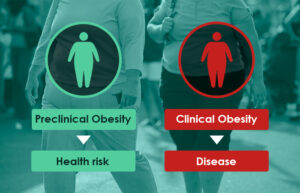On January 14, 2025, the prestigious journal The Lancet Diabetes & Endocrinology published a groundbreaking report redefining obesity and establishing new diagnostic criteria. This Commission, led by Professor Francesco Rubino from King’s College London, emerged in response to the lack of global consensus on obesity classification and definition, despite the fact that it affects nearly one-eighth of the world’s population.
A) A New Approach to Obesity Classification
The Commission distinguishes between two forms of obesity:
- Preclinical Obesity: Characterized by excess adiposity without current organ dysfunction or limitations in daily activities, but with a higher future health risk.
- Clinical Obesity: Considered a chronic systemic disease directly caused by excess adiposity and its effects on the body.

To define these conditions, the Commission suggests using additional measurements alongside BMI, such as waist circumference, waist-to-hip ratio, and waist-to-height ratio. This approach aims to overcome the limitations of BMI, a traditional but imprecise method that does not distinguish between different types of body fat or their impact on health.
B) Impact on Diagnosis and Treatment
The new diagnostic framework will:
– Improve early detection of obesity and its associated risks.
– Facilitate access to personalized treatments, prioritizing those who truly need interventions such as surgery or medication.
– Optimize prevention strategies for individuals with preclinical obesity through lifestyle changes and personalized medical evaluations.

However, implementing this new model also presents challenges. It requires a more thorough medical evaluation, which could increase the workload for healthcare professionals and associated costs. Despite this, experts believe that maintaining an inaccurate diagnostic system would be even more costly for both healthcare systems and patients.
C) A Necessary Shift in Obesity Epidemiology
The study also highlights the need to update epidemiological data on obesity, which has so far been based solely on BMI. Preliminary audits indicate that a significant number of individuals classified as obese by BMI would not meet the criteria for clinical obesity. This underscores the importance of collecting more comprehensive health data and exploring the possibility of stratifying clinical obesity into subtypes based on its pathophysiology and clinical manifestations.
D) A Future with a Personalized Approach
The redefinition of obesity proposed by this Commission marks a significant shift in how this condition is understood and treated. The goal is to move away from a one-size-fits-all view of obesity and adopt an approach that recognizes the diverse health profiles and needs of each individual.
This change will not only transform healthcare but could also help reduce the stigma associated with obesity by promoting a more empathetic and evidence-based understanding. With this new perspective, the objective is to improve the quality of life for millions of people worldwide and advance toward fairer and more effective treatment strategies.


I have read some excellent stuff here Definitely value bookmarking for revisiting I wonder how much effort you put to make the sort of excellent informative website.
I’m really inspired with your writing skills as smartly as with the format for your blog.
Is that this a paid topic or did you modify it yourself?
Anyway keep up the excellent quality writing, it is uncommon to look a nice blog like this
one nowadays. Leonardo AI x Midjourney!
Nice